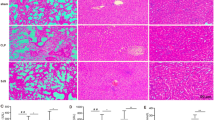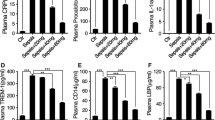Abstract
Objective
To explore the pharmacological anti-inflammatory mechanism of Chinese formula Qingwen Baidu Decoction (清瘟败毒饮, QBD) from the view of holistic biology.
Methods
The rats were randomly divided into a normal conrol group, a lipopolysaccharide (LPS) group, the low- and high-dose QBD groups, and a dexamethasone (DXM) group. NR8383 cells were treated with culture fluid containing 6% serum from rats of each group respectively. Inflammatory mediators were detected by reverse transcription polymerase chain reaction (RT-PCR), Western blotting hybridization, enzyme linked immunosorbent assay (ELISA), polymerase chain reaction (PCR) gene array and antibody array.
Results
It is showed that the levels of interleukin (IL)-1α, IL-4 and IL-12 were enhanced in the low-dose QBD group; levels of IL-1α, IL-12 and IL-18 were augmented in the high-dose QBD group, compared with the LPS group after ELISA detection. Western blot showed that IL-1β and tumor necrosis factor (TNF)-α expression of the control group were lower than other groups. IL-1β level of the low-dose and high-dose QBD groups detected by RT-PCR was higher in early stage but lower after 24 h than that of the control group (P<0.01). Expression of 84 main inflammatory cytokines and receptors was detected by rat inflammatory cytokines and receptors PCR array. Up-regulation genes were 22 in both the LPS group and the low-dose QBD group, among which 16 up-regulating genes were the same. In these 16 genes, the up-regulating amplitude of 9 genes in the low-dose QBD group was less than that in the LPS group, 4 were similar to and 3 were more. Twenty-nine main cytokines were inspected by rat cytokine antibody array. Intergroup gray value differences were found in 7 expressed cytokines. The levels of these 7 cytokines in the lowdose QBD group were all lower than those in the the LPS group.
Conclusions
QBD has anti-inflammatory effect on sepsis by changing the level of inflammatory mediators.
Similar content being viewed by others
References
Gazin V, Kerdine S, Grillon G, Pallardy M, Raoul H. Uranium induces TNF alpha secretion and MAPK activation in a rat alveolar macrophage cell line. Toxicol Appl Pharmacol 2004;194:49–59.
Helmke RJ, German VF, Mangos JA. A continuous alveolar macrophage cell line: comparisons with freshly derived alveolar macrophages. In Vitro Cell Dev Biol 1989;25:44–48.
Deitch EA, Redl H, Schlag G, Bahrami S. Animal models of sepsis and shock: a review and lessons learned. Shock 1998;9:1–11.
Watson J, Riblet R, Taylor BA. The response of recombinant inbred strains of mice to bacterial lipopolysaccharides. J Immunol 1997;118:2088–2093.
Yu ZM, Liu ZH, Chen J, Zhu HL. Influence of decoction for clearing away pestilent factors and detoxification on inflammatory mediators in summer heat syndrome rats of epidemic febrile disease. Pharmacol Clin Chin Mater Med (Chin) 2010;28:286–288.
Yu ZM, Xu QW, Pang ZY, Zhou XJ, Li XJ. Endueing summer heat syndrome rat model of epidemic febrile disease by lipopolysaccharide infusion and high temperature environment. J Liaoning Univ Chin Med (Chin) 2010;12:18–20.
Yu ZM, Chen J, Liu ZH, Zhu HL, Zhong JX. Influence of decoction for clearing away pestilent factors and detoxification on IL-1, 6, 10, 18, TNF-α, IFN-γ of rabbits with systemic inflammatory response syndrome. Pharmacol Clin Chin Mater Med (Chin) 2009;25:3–6.
Jiang JX, ed. Bacterial endotoxin and clinic. Beijing: People’s Military Medical Press; 2004:188–189.
Dinarello CA. Proinflammatory cytokines. Chest 2000;118:503–508.
Mazolewski PJ, Barber A, Williams S, Simoni J, Davis S, Shires GT. Attenuating tumor necrosis factor alpha does not ameliorate other cytokine and peroxidase products during sepsis. Am J Surg 1999;178:556–559.
Pestaña D, Casanova E, Villagrán MJ, Tormo C, Pérez-Chrzanowska H, Redondo J, et al. Continuous hemofiltration in hyperthermic septic shock patients. J Trauma 2007;63:751–756.
Page M, Hayi-Slayman D, Ber CE, Christin F, Baillon JJ, Bret M, et al. Use of coupled plasma filtration adsorption for septic shock treatment. Ann Fr Anesth Reanim 2007;26:990–993.
Patel GP, Balk RA. Systemic steroids in severe sepsis and septic shock. Am J Respir Crit Care Med 2012;185:133–139.
Sprung CL, Brezis M, Goodman S, Weiss YG. Corticosteroid therapy for patients in septic shock: some progress in a difficult decision. Crit Care Med 2011;39:571–574.
Branca M. Genetics and medicine: putting gene arrays to the test. Science 2003;300:238.
Perissi V, Aggarwal A, Glass CK, Rose DW, Rosenfeld MG. A corepressor/coactivator exchange complex required for transcriptional activation by nuclear receptors and other regulated transcription factors. Cell 2004;116:511–526.
Sze SK, de Kleijn DP, Lai RC, Tan EK, Zhao H, Yeo KS, et al. Elucidating the secretion proteome of human ESCderived mesenchymal stem cells. Mol Cell Proteomics 2007;6:1680–1689.
Wingren C, Borrebaeck CA. Antibody-based microarrays. Methods Mol Biol 2009;509:57–84.
Uhlén M, Björling E, Agaton C, Szigyarto CA, Amini B. A human protein atlas for normal and cancer tissues based on antibody proteomics. Mol Cell Proteom 2005;4:1920–1932.
Celis JE, Moreira JM, Cabezón T, Gromov P, Friis E, Rank F, et al. Identification of extracellular and intracellular signaling components of the mammary sdipose tissue and its interstitial fluid in high risk breast cancer patients. Molecul Cell Proteom 2005;4:492–522.
Carlsson A, Persson O, Ingvarsson J, Widegren B, Salford L, Borrebaeck CA, et al. Plasma proteome profiling reveals biomarker patterns associated with prognosis and therapy selection in glioblastoma multiforme patients. Proteomics Clin Appl 2010;4:591–602.
Lindskog C, Asplund A, Engkvist M, Uhlen M, Korsgren O, Ponten F. Antibody-based proteomics for discovery and exploration of proteins expressed in pancreatic islets. Discov Med 2010;9:565–578.
Hu H, Kwun J, Aizenstein BD, Knechtle SJ. Noninvasive detection of acute and chronic injuries in human renal transplant by elevation of multiple cytokines/chemokines inurine. Transplantation 2009;87:1814–1820.
Rangel-Moreno J, Hartson L, Navarro C, Gaxiola M, Selman M, Randall TD. Inducible bronchus-associated lymphoid tissue (iBALT) in patients with pulmonary complications of rheumatoid arthritis. J Clin Invest 2006;116:3183–3194.
Aubin E, Lemieux R, Bazin R. Absence of cytokine modulation following therapeutic infusion of intravenous immunoglobulin or anti-red blood cell antibodies in a mouse model of immune thrombocytopenic purpura. Br J Haematol 2007;136:837–843.
Author information
Authors and Affiliations
Corresponding author
Additional information
Supported by National Natural Science Foundation of China (No. 30801468)
Rights and permissions
About this article
Cite this article
Yu, Zm., Liu, Zh., Chen, J. et al. Anti-inflammatory effect of Qingwen Baidu Decoction (清瘟败毒饮) in sepsis rats. Chin. J. Integr. Med. 20, 934–943 (2014). https://doi.org/10.1007/s11655-014-1863-x
Received:
Published:
Issue Date:
DOI: https://doi.org/10.1007/s11655-014-1863-x




